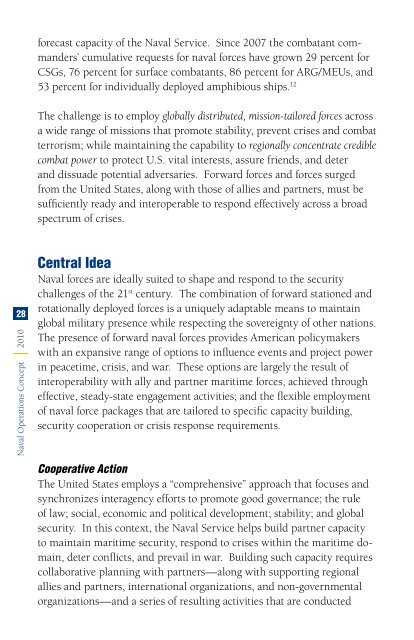Naval Operations Concept - Defense Technical Information Center
Naval Operations Concept - Defense Technical Information Center
Naval Operations Concept - Defense Technical Information Center
Create successful ePaper yourself
Turn your PDF publications into a flip-book with our unique Google optimized e-Paper software.
<strong>Naval</strong> <strong>Operations</strong> <strong>Concept</strong> 2010<br />
forecast capacity of the <strong>Naval</strong> Service. Since 2007 the combatant commanders’<br />
cumulative requests for naval forces have grown 29 percent for<br />
CSGs, 76 percent for surface combatants, 86 percent for ARG/MEUs, and<br />
53 percent for individually deployed amphibious ships. 12<br />
The challenge is to employ globally distributed, mission-tailored forces across<br />
a wide range of missions that promote stability, prevent crises and combat<br />
terrorism; while maintaining the capability to regionally concentrate credible<br />
combat power to protect U.S. vital interests, assure friends, and deter<br />
and dissuade potential adversaries. Forward forces and forces surged<br />
from the United States, along with those of allies and partners, must be<br />
sufficiently ready and interoperable to respond effectively across a broad<br />
spectrum of crises.<br />
Central Idea<br />
<strong>Naval</strong> forces are ideally suited to shape and respond to the security<br />
challenges of the 21 st century. The combination of forward stationed and<br />
rotationally deployed forces is a uniquely adaptable means to maintain<br />
global military presence while respecting the sovereignty of other nations.<br />
The presence of forward naval forces provides American policymakers<br />
with an expansive range of options to influence events and project power<br />
in peacetime, crisis, and war. These options are largely the result of<br />
interoperability with ally and partner maritime forces, achieved through<br />
effective, steady-state engagement activities; and the flexible employment<br />
of naval force packages that are tailored to specific capacity building,<br />
security cooperation or crisis response requirements.<br />
Cooperative Action<br />
The United States employs a “comprehensive” approach that focuses and<br />
synchronizes interagency efforts to promote good governance; the rule<br />
of law; social, economic and political development; stability; and global<br />
security. In this context, the <strong>Naval</strong> Service helps build partner capacity<br />
to maintain maritime security, respond to crises within the maritime domain,<br />
deter conflicts, and prevail in war. Building such capacity requires<br />
collaborative planning with partners—along with supporting regional<br />
allies and partners, international organizations, and non-governmental<br />
organizations—and a series of resulting activities that are conducted

















